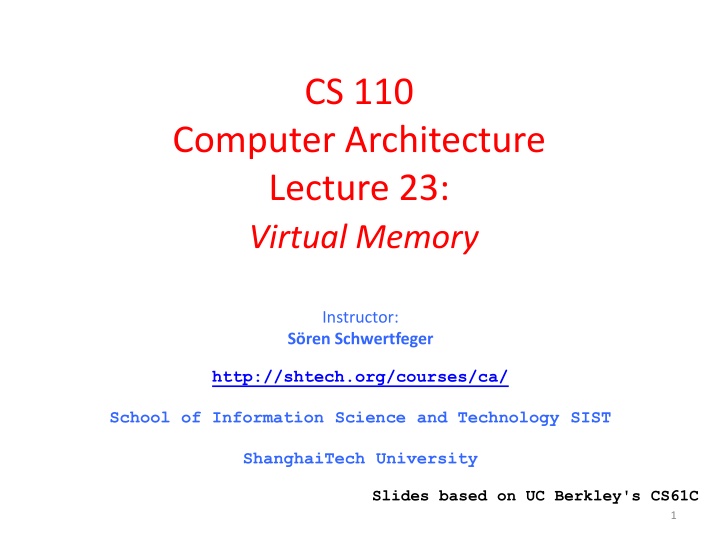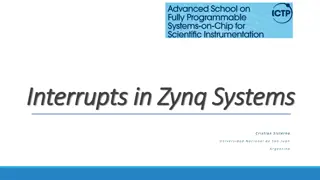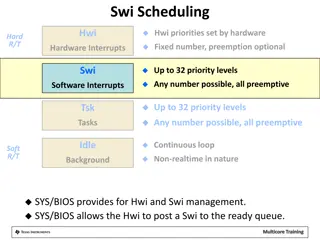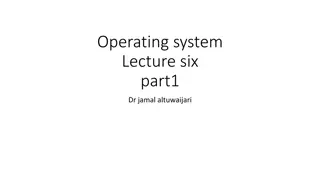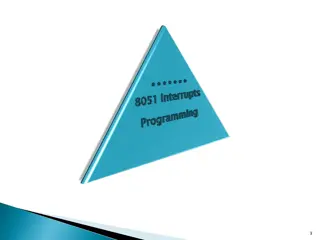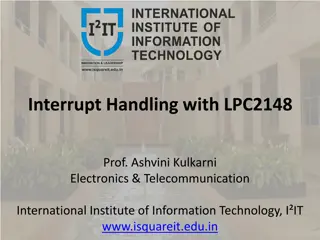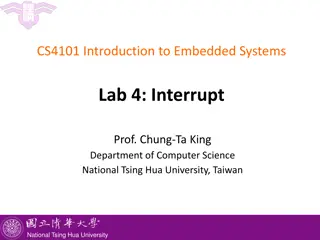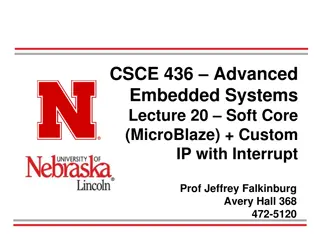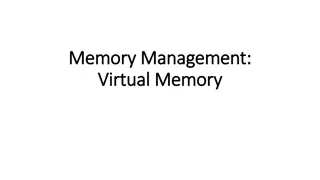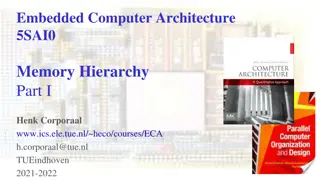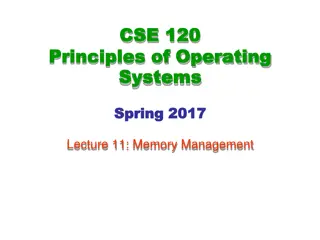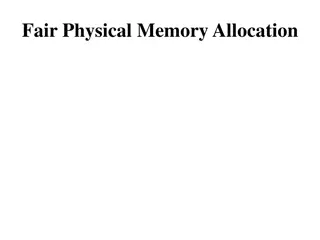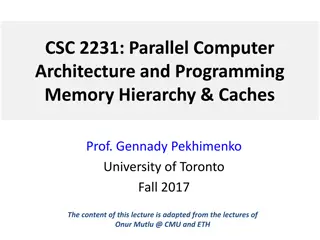Virtual Memory and Interrupt Handling in Computer Architecture
This lecture covers topics such as virtual memory, programmed I/O, interrupts, traps/exceptions, terminology in computer architecture, precise traps, and trap handling in 5-stage pipeline. Explore the complexities of handling interrupts and exceptions in a computer system.
Download Presentation

Please find below an Image/Link to download the presentation.
The content on the website is provided AS IS for your information and personal use only. It may not be sold, licensed, or shared on other websites without obtaining consent from the author.If you encounter any issues during the download, it is possible that the publisher has removed the file from their server.
You are allowed to download the files provided on this website for personal or commercial use, subject to the condition that they are used lawfully. All files are the property of their respective owners.
The content on the website is provided AS IS for your information and personal use only. It may not be sold, licensed, or shared on other websites without obtaining consent from the author.
E N D
Presentation Transcript
CS 110 Computer Architecture Lecture 23: Virtual Memory Instructor: S ren Schwertfeger http://shtech.org/courses/ca/ School of Information Science and Technology SIST ShanghaiTech University Slides based on UC Berkley's CS61C 1
Review Programmed I/O Polling vs. Interrupts Booting a Computer BIOS, Bootloader, OS Boot, Init Supervisor Mode, Syscalls Base and Bounds Simple, but doesn t give us everything we want Intro to VM 2
Traps/Interrupts/Exceptions: altering the normal flow of control Ii-1 HI1 trap handler HI2 program Ii Ii+1 HIn An external or internal event that needs to be processed - by another program the OS. The event is often unexpected from original program s point of view. 3
Terminology In CA (you ll see other definitions in use elsewhere): Interrupt caused by an event external to current running program (e.g. key press, mouse activity) Asynchronous to current program, can handle interrupt on any convenient instruction Exception caused by some event during execution of one instruction of current running program (e.g., page fault, bus error, illegal instruction) Synchronous, must handle exception on instruction that causes exception Trap action of servicing interrupt or exception by hardware jump to trap handler code 4
Precise Traps Trap handler s view of machine state is that every instruction prior to the trapped one has completed, and no instruction after the trap has executed. Implies that handler can return from an interrupt by restoring user registers and jumping back to interrupted instruction (EPC register will hold the instruction address) Interrupt handler software doesn t need to understand the pipeline of the machine, or what program was doing! More complex to handle trap caused by an exception than interrupt Providing precise traps is tricky in a pipelined superscalar out-of-order processor! But handling imprecise interrupts in software is even worse. 5
Trap Handling in 5-Stage Pipeline Inst. Mem Data Mem Decode PC D E M W + PC address Exception Illegal Opcode Data address Exceptions Overflow Asynchronous Interrupts How to handle multiple simultaneous exceptions in different pipeline stages? How and where to handle external asynchronous interrupts? 6
Save Exceptions Until Commit Commit Point Inst. Mem Data Mem Decode PC D E M W + Illegal Opcode Data address Exceptions Overflow PC address Exception Cause Exc D Exc E Exc M EPC PC D PC E PC M Select Handler PC Asynchronous Interrupts Kill Kill F Stage Kill D Stage Kill E Stage Writeback 7
Handling Traps in In-Order Pipeline Hold exception flags in pipeline until commit point (M stage) Exceptions in earlier instructions override exceptions in later instructions Exceptions in earlier pipe stages override later exceptions for a given instruction Inject external interrupts at commit point (override others) If exception/interrupt at commit: update Cause and EPC registers, kill all stages, inject handler PC into fetch stage 8
Trap Pipeline Diagram time t0 IF1 ID1 EX1 MA1 - IF2 ID2 EX2 - IF3 ID3 - t1 t2 t3 t4 t5 t6 overflow! t7 . . . . (I1) 096: ADD (I2) 100: XOR (I3) 104: SUB (I4) 108: ADD (I5) Trap Handler code - - - - - IF4 - - IF5 ID5 EX5 MA5 WB5 9
Bare 5-Stage Pipeline Physical Address Physical Address Inst. Cache Data Cache Decode PC D E M W + Memory Controller Physical Address Physical Address Physical Address Main Memory (DRAM) In a bare machine, the only kind of address is a physical address 11
What do we need Virtual Memory for? Reason 1: Adding Disks to Hierarchy Need to devise a mechanism to connect memory and disk in the memory hierarchy 12
What do we need Virtual Memory for? Reason 2: Simplifying Memory for Apps Applications should see the straightforward memory layout we saw earlier -> User-space applications should think they own all of memory So we give them a virtual view of memory ~ 7FFF FFFFhex stack heap static data code ~ 0000 0000hex 13
What do we need Virtual Memory for? Reason 3: Protection Between Processes With a bare system, addresses issued with loads/stores are real physical addresses This means any program can issue any address, therefore can access any part of memory, even areas which it doesn t own Ex: The OS data structures We should send all addresses through a mechanism that the OS controls, before they make it out to DRAM - a translation mechanism 14
Address Spaces The set of addresses labeling all of memory that we can access Now, 2 kinds: Virtual Address Space - the set of addresses that the user program knows about Physical Address Space - the set of addresses that map to actual physical cells in memory Hidden from user applications So, we need a way to map between these two address spaces 15
Blocks vs. Pages In caches, we dealt with individual blocks Usually ~64B on modern systems We could divide memory into a set of blocks In VM, we deal with individual pages Usually ~4 KB on modern systems Now, we ll divide memory into a set of pages Common point of confusion: Bytes, Words, Blocks, Pages are all just different ways of looking at memory! 16
Bytes, Words, Blocks, Pages Ex: 16 KiB DRAM, 4 KiB Pages (for VM), 128 B blocks (for caches), 4 B words (for lw/sw) 1 Page 1 Block Block 31 Word 31 1 Memory Page 3 Can think of a page as: - 32 Blocks OR - 1024 Words Can think of memory as: - 4 Pages OR - 128 Blocks OR - 4096 Words Page 2 16 KiB Page 1 Page 0 Block 0 Word 0 17
Address Translation So, what do we want to achieve at the hardware level? Take a Virtual Address, that points to a spot in the Virtual Address Space of a particular program, and map it to a Physical Address, which points to a physical spot in DRAM of the whole machine Virtual Address Virtual Page Number Offset Physical Address Physical Page Number Offset 18
Address Translation Virtual Address Virtual Page Number Offset Address Translation Copy Bits Physical Address Physical Page Number Offset The rest of the lecture is all about implementing 19
Paged Memory Systems Processor-generated address can be split into: Virtual Page Number Offset A page table contains the physical address of the base of each page 1 0 0 1 2 3 0 1 2 3 Physical Memory 3 Address Space of Program #1 Page Table of Program #1 2 Page tables make it possible to store the pages of a program non-contiguously. 20
Private (Virtual) Address Space per Program OS pages Prog 1 VA1 Page Table Prog 2 Physical Memory VA1 Page Table VA1 Prog 3 Page Table free Each program has a page table Page table contains an entry for each prog page Physical Memory acts like a cache of pages for currently running programs. Not recently used pages are stored in secondary memory, e.g. disk (in swap partition ) 21
Where Should Page Tables Reside? Space required by the page tables (PT) is proportional to the address space, number of users, ... = Too large to keep in registers inside CPU Idea: Keep page tables in the main memory Needs one reference to retrieve the page base address and another to access the data word = doubles the number of memory references! (but we can fix this using something we already know about ) 22
Page Tables in Physical Memory PT Prog1 VA1 PT Prog2 Physical Memory Prog 1 Virtual Address Space VA1 Prog 2 Virtual Address Space 23
Linear (simple) Page Table Data Pages Page Table Entry (PTE) contains: 1 bit to indicate if page exists And either PPN or DPN: PPN (physical page number) for a memory-resident page DPN (disk page number) for a page on the disk Status bits for protection and usage (read, write, exec) OS sets the Page Table Base Register whenever active user process changes Page Table PPN PPN DPN PPN Data word Offset DPN PPN PPN DPN DPN VPN DPN PPN PPN VPN PT Base Register Offset Virtual address 24
Suppose an instruction references a memory page that isn t in DRAM? We get a exception of type page fault Page fault handler does the following: If virtual page doesn t yet exist, assign an unused page in DRAM, or if page exists Initiate transfer of the page we re requesting from disk to DRAM, assigning to an unused page If no unused page is left, a page currently in DRAM is selected to be replaced (based on usage) The replaced page is written (back) to disk, page table entry that maps that VPN->PPN is marked as invalid/DPN Page table entry of the page we re requesting is updated with a (now) valid PPN 25
Size of Linear Page Table With 32-bit memory addresses, 4-KB pages: => 232 / 212 = 220 virtual pages per user, assuming 4-Byte PTEs, => 220 PTEs, i.e, 4 MB page table per user! Larger pages? Internal fragmentation (Not all memory in page gets used) Larger page fault penalty (more time to read from disk) What about 64-bit virtual address space??? Even 1MB pages would require 244 8-Byte PTEs (35 TB!) What is the saving grace ? Most processes only use a set of high address (stack), and a set of low address (instructions, heap) 26
Hierarchical Page Table exploits sparcity of virtual address space use Virtual Address 11 12 21 22 31 0 p1p2 offset 10-bit L1 index 10-bit L2 index Physical Memory Root of the Current Page Table p2 p1 (Processor Register) Level 1 Page Table Level 2 Page Tables page in primary memory page in secondary memory PTE of a nonexistent page Data Pages 27
Address Translation & Protection Virtual Address Virtual Page No. (VPN) offset Kernel/User Mode Read/Write Address Translation Protection Check Exception? Physical Address Physical Page No. (PPN) offset Every instruction and data access needs address translation and protection checks A good VM design needs to be fast (~ one cycle) and space efficient 28
Translation Lookaside Buffers (TLB) Address translation is very expensive! In a two-level page table, each reference becomes several memory accesses Solution: Cache some translations in TLB TLB hit = Single-Cycle Translation TLB miss = Page-Table Walk to refill virtual address VPN offset (VPN = virtual page number) V R W D tag PPN (PPN = physical page number) hit? physical address PPN offset 29
TLB Designs Typically 32-128 entries, usually fully associative Each entry maps a large page, hence less spatial locality across pages => more likely that two entries conflict Sometimes larger TLBs (256-512 entries) are 4-8 way set- associative Larger systems sometimes have multi-level (L1 and L2) TLBs Random or FIFO replacement policy TLB Reach : Size of largest virtual address space that can be simultaneously mapped by TLB Example: 64 TLB entries, 4KB pages, one page per entry TLB Reach = _____________________________________________? 30
VM-related events in pipeline Inst TLB Inst. Cache Data TLB Data Cache Decode PC D E M W + TLB miss? Page Fault? Protection violation? TLB miss? Page Fault? Protection violation? Handling a TLB miss needs a hardware or software mechanism to refill TLB usually done in hardware now Handling a page fault (e.g., page is on disk) needs a precise trap so software handler can easily resume after retrieving page Handling protection violation may abort process 31
Hierarchical Page Table Walk: SPARC v8 Index 1 Index 2 Index 3 Offset 31 23 17 11 0 Context Table Virtual Address Context Table Register L1 Table root ptr Context Register L2 Table PTP L3 Table PTP PTE 31 11 0 Offset Physical Address PPN MMU does this table walk in hardware on a TLB miss 32
Page-Based Virtual-Memory Machine (Hardware Page-Table Walk) Page Fault? Protection violation? Page Fault? Protection violation? Virtual Address Virtual Address Physical Address Physical Address Inst. TLB Inst. Cache Data TLB Data Cache Decode PC D E M W + Miss? Miss? Page-Table Base Register Hardware Page Table Walker Physical Address Physical Address Memory Controller Physical Address Main Memory (DRAM) Assumes page tables held in untranslated physical memory 33
Address Translation: putting it all together Virtual Address hardware hardware or software software TLB Lookup miss hit Protection Check Page Table Walk the page is not in memory denied permitted in memory Protection Fault Page Fault (OS loads page) Physical Address (to cache) Update TLB Where? SEGFAULT 34
Modern Virtual Memory Systems Illusion of a large, private, uniform store Protection & Privacy several users, each with their private address space and one or more shared address spaces page table = name space OS useri Swapping Store (Disk) Demand Paging Provides the ability to run programs larger than the primary memory Primary Memory Hides differences in machine configurations The price is address translation on each memory reference mapping TLB VA PA 35
Conclusion: VM features track historical uses Bare machine, only physical addresses One program owned entire machine Batch-style multiprogramming Several programs sharing CPU while waiting for I/O Base & bound: translation and protection between programs (not virtual memory) Problem with external fragmentation (holes in memory), needed occasional memory defragmentation as new jobs arrived Time sharing More interactive programs, waiting for user. Also, more jobs/second. Motivated move to fixed-size page translation and protection, no external fragmentation (but now internal fragmentation, wasted bytes in page) Motivated adoption of virtual memory to allow more jobs to share limited physical memory resources while holding working set in memory Virtual Machine Monitors Run multiple operating systems on one machine Idea from 1970s IBM mainframes, now common on laptops e.g., run Windows on top of Mac OS X Hardware support for two levels of translation/protection Guest OS virtual -> Guest OS physical -> Host machine physical Also basis of Cloud Computing Virtual machine instances on EC2 36
